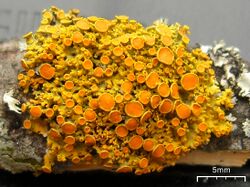Biology:Gallowayella hasseana
| Gallowayella hasseana | |
|---|---|

| |
| Scientific classification | |
| Domain: | Eukaryota |
| Kingdom: | Fungi |
| Division: | Ascomycota |
| Class: | Lecanoromycetes |
| Order: | Teloschistales |
| Family: | Teloschistaceae |
| Genus: | Gallowayella |
| Species: | G. hasseana
|
| Binomial name | |
| Gallowayella hasseana (Räsänen) S.Y.Kondr., Fedorenko, S.Stenroos, Kärnefelt, Elix, Hur & A.Thell (2012)
| |
| Synonyms[1] | |
| |
Gallowayella hasseana, the poplar sunburst lichen, is a species of corticolous (bark-dwelling), crustose lichen in the family Teloschistaceae.[2] It occurs in North America.
Taxonomy
The lichen was first formally described as a new species in 1944 by Finnish lichenologist Veli Räsänen as Xanthoria hasseana.[3] Over a half-century later, it was transferred to Xanthomendoza.[4] Sergey Kondratyuk and Ingvar Kärnefelt proposed a transfer to genus Oxneria in 2003.[5] In 2012, the genus Gallowayella was circumscribed, and this species transferred to it.[6] The species is commonly known as the "poplar sunburst lichen".[7]
Description
The lichen has a yellowish-orange thallus comprising small, overlapping [[Glossary of lichen terms#{{biology:{1}}}|{{Biology:{1}}}]] (measuring 0.3–0.9 mm wide) arranged in a loosely attached rosette. The thallus undersurface is white, and attaches to the bark [[Glossary of lichen terms#{{biology:{1}}}|{{Biology:{1}}}]] by relatively long rhizines. There are neither isidia nor soredia on the thallus surface. Apothecia, usually numerous in the center of the thallus, have dark orange [[Glossary of lichen terms#{{biology:{1}}}|{{Biology:{1}}}]] and are 0.6–3 mm in diameter. Ascospores are ellipsoid in shape with a single septum, and have typical dimensions of 15.5–18 by 7.5–9.5 μm.[7]
Gallowayella hasseana mostly grows on bark (especially poplar bark), although it has occasionally been recorded on rock or on wood. It prefers open or partially shaded areas.[7]
References
- ↑ "Synonymy: Gallowayella hasseana (Räsänen) S.Y. Kondr., Fedorenko, S. Stenroos, Kärnefelt, Elix, Hur & A. Thell, in Fedorenko, Stenroos, Thell, Kärnefelt, Elix, Hur & Kondratyuk, Biblthca Lichenol. 108: 57 (2012)". Species Fungorum. http://www.speciesfungorum.org/Names/SynSpecies.asp?RecordID=586788.
- ↑ "Gallowayella hasseana (Räsänen) S.Y. Kondr., Fedorenko, S. Stenroos, Kärnefelt, Elix, Hur & A. Thell". Species 2000: Naturalis, Leiden, the Netherlands. https://www.catalogueoflife.org/data/taxon/3F725.
- ↑ Räsänen, V. (1944). "Lichenes novi I". Annales Botanici Societatis Zoologicae Botanicae Fennicae "Vanamo" 20 (3): 1–34.
- ↑ Kondratyuk, S.; Kärnefelt, I. (1997). "Josefpoeltia and Xanthomendosa, two new genera in the Teloschistaceae (lichenized Ascomycotina)". Bibliotheca Lichenologica 68: 19–44.
- ↑ Kondratyuk, S.Y.; Kärnefelt, I. (2003). "Revision of three natural groups of xanthorioid lichens (Teloschistaceae, Ascomycota)". Ukrainskiy Botanichnyi Zhurnal 60 (4): 427–437.
- ↑ Fedorenko, N.M.; Stenroos, S.; Thell, A.; Kärnefelt, I.; Elix, J.A.; Hur, J.-S.; Kondratyuk, S.Y. (2012). "Molecular phylogeny of xanthorioid lichens (Teloschistaceae, Ascomycota), with notes on their morphology". Bibliotheca Lichenologica 108: 45–64.
- ↑ 7.0 7.1 7.2 Brodo, Irwin M.; Sharnoff, Sylvia Duran; Sharnoff, Stephen (2001). Lichens of North America. Yale University Press. p. 746. ISBN 978-0-300-08249-4.
Wikidata ☰ Q107691777 entry
 |

